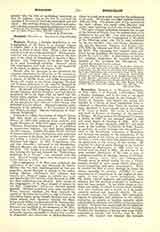

Bouquet, MARTIN, a learned Benedictine of the Congregation of St.-Maur, b. at Amiens, France, August 6, 1685; d. at the monastery of Blancs-Manteaux, in Paris, April 6, 1754. When a boy he resolved to enter the secular priesthood. Subsequently, however, not wishing to expose his soul to the dangers of the world, he determined to become a Benedictine. The Congregation of St.-Maur was then in its most flourishing condition. Bouquet joined this congregation and took vows at the monastery of St.-Faron, at Meaux, August 16, 1706.
Shortly after his elevation to the priesthood his superiors appointed him librarian at the monastery of St.-Germain-des-Pres which at that time possessed a library of 60,000 books and 8,000 manuscripts. Being well versed in the Greek language, Bouquet was of great assistance to his confrere, Bernard de Montfaucon, in his edition of the works of St. Chrysostom. He himself was preparing a new edition of the Jewish historian, Flavius Josephus, and had already progressed far in his work when he heard that the Dutch writer, Sigebert Haverkamp, was engaged on a new edition of the same author. He at once sent all the material he had collected to Haverkamp, who embodied it in his edition. Bouquet’s greatest work, however, is his collection of the historians of Gaul and France, entitled: “Rerum Gallicarum et Francicarum Scriptores”.
Attempts to collect the sources of French history had been made at various times. Thus Pierre Pithou (d. 1596) had collected some material, and Andre Duchesne (d. 1640) had begun a work entitled “Historiae Francorum Scriptores”, to be published in twenty-four volumes, but died before finishing the fifth volume. Colbert, the great French minister of finance, desired to have Duchesne’s work continued at the expense of the State, but he died in 1683 without finding a suitable historian to complete what Duchesne had begun. In 1717, D’Aguesseau, who was then chancellor, entrusted to the Benedictine, Edmond Marten, the drawing up of a new plan for the work. The design was accepted and the Oratorian LeLong who had just finished his “Bibliotheque historique de la France” was entrusted with the task. He had scarcely begun when death put an end to his labors in 1721.
The Congregation of St.-Maur now undertook the publication of the work and Dionysius de Sainte-Marthe, who was then superior-general of the congregation, placed Bouquet in charge of the undertaking. Because Duchesne’s five volumes had become rare, Bouquet began an entirely new work and had the first two volumes ready for print in 1729, but their publication was delayed. Some monks of the Congregation of St.-Maur refused to submit to the Bull “Unigenitus” which was directed against Quesnel. Bouquet submitted after some hesitation. When, however, Cardinal De Bissy required the monks of St.-Germain-des-Pres to sign a formula of submission drawn up by himself, Bouquet and seven others refused their signature because De Bissy, being merely Abbot in commendam of St.-Germain-des-Pres, had no spiritual jurisdiction over the monks. Bouquet was banished to the monastery of St.-Jean, at Laon, but in 1735, D’Aguesseau and a few other influential persons succeeded in having him recalled to Argenteuil, and afterwards to Blancs-Manteaux, where he could more easily supervise the publication of his work. He brought out eight volumes between 1738 and 1752. The greater part of the material for the ninth volume was ready when Bouquet died (1754), after receiving the last rites of the Church.
The eight volumes published comprise the sources of the history of France from the earliest days of its existence to the year 987. The work was continued by other members of the Congregation of St.-Maur in the following order: vols. IX-X were published by the two brothers, John and Charles Haudiquier; vol. XI, by Housseau, Precieux, and Poirier; vols. XII-XIII, by Clement and Brial; vols. XIV-XVIII, by Brial. The remaining five volumes were published by the Academie des Inscriptions which completed the work in 1876. A new edition in twenty-five volumes, undertaken by Leopold Delisle, a member of the Academie des Inscriptions, has reached the twenty-fourth volume.
MICHAEL OTT

